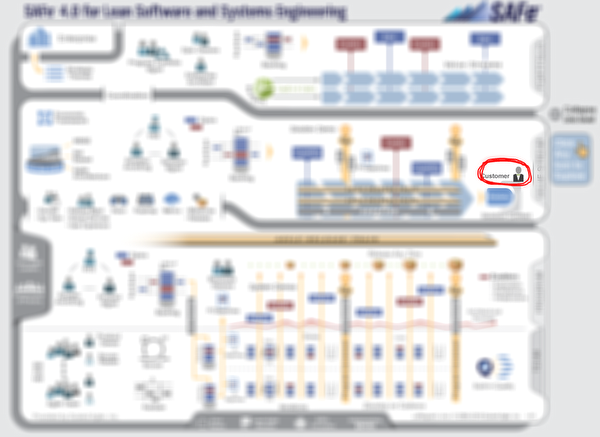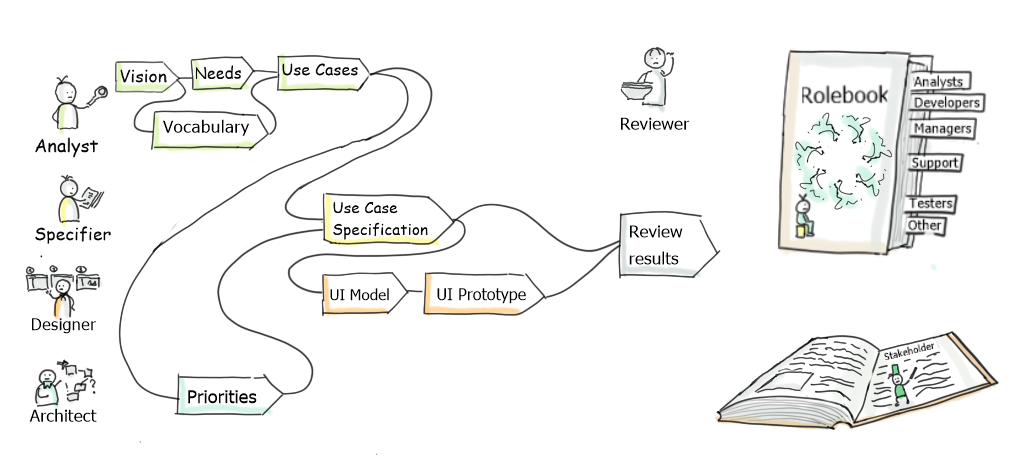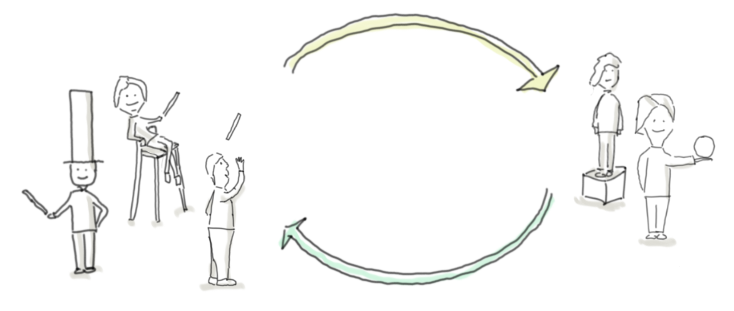If you never have had a look at the scaled agile framework, you may want to do so. It’s has some really good concepts in it. Still with all the enthusiasm I feel like being drawn back to the good old times of software engineering. And you know why?

Have you looked closely at the SAFe picture? Here’s the link if you need to see it in full: http://www.scaledagileframework.com
Did you find users or customers and collaboration with them?
I couldn’t find users but I was able to spot the customer:

Here by the way the two pictures drawn from the rational unified process I used more than fifteen years ago to point out the major flaws of software engineering at that time. Do you find any resemblance?

The rational unified process had stakeholders under additional roles just sorted after any role, users are not even mentioned. In SAFe, customers are just where the release train ends, users are nowhere to see either.
Is creating products really just about backlogs, release trains, value streams, features and that stuff? We behave as if the big challenge of creating great and successful software products was to manage the work packages for the development teams!
The teams I’ve seen really struggled to establish a tight and fruitful collaboration with their customers and users so they would build software with higher value rather than delivering mediocre features more efficiently!
How will we ever be able to successfully develop software if getting the backlog items right is our focal point of attention instead of market, customers and users?
Agile frameworks lead us up the garden path. They put so much of our attention on oiling the backlogs that those people who make key decisions about products have no time talking to their customer and users.
There is still a lot to learn. And it seems that in spite of all agile methodology, we are very reluctant learners. See e.g. Pete’s post: https://starstoroad.com/blog/?p=706. A bit more common sense than large frameworks would really help the world.
So this is the big picture you need to strive for:

The discussion spread into our corporate communication tool. Here are a few excellent replies:
Markus: “SAFe [..] still did not understand what really matters about software product development. Or to almost quote google “Focus on users/customers and everything else follows”. For me SAFe is just a more effective way to build the wrong stuff. [..] Why bother about a machine that turns backlog items into code. [..] Where is the creative new solution? Where are the feedbackloops? Where are users and customers? Where is the impact? Where is the team? I just see a production line with loads of individuals pulling triggers”
Reply 1: “http://www.barryovereem.com/operational-excellence-3/”
Reply 2: “You might want to look at it into more details and/or [..] we can point you to the feedback loops and innovation elements ;-). Where are you on the SAFe related wisdom curve?”
Reply 3: “SAFe contains all the feedback loops, also on market impact level [..] the overview map and also most of the trainings indeed focus on delivery at scale. [..] a lot of IT departments of larger companies are still not able at all to deliver larger pieces of working software in time and budget, [..They] are neither extraordinary innovative nor considerably user need driven. [..] A well oiled backlog to code to production factory is a key element [..] We do not have to talk about closed feedback loops on market impact level as long as time to market is counted in years.”
Reply 4: “[..] SAFe is not about the shiny world of start-ups and Silicon Valley companies but about picking up [..] companies in there current waterfall/silos world and help them transform toward more integrated and agile ways of working. SAFe [..] proves to be very successful at that. [..] I’m sure you can implement SAFe in many terrible ways [..]. But that is not what it is intended for!”
My favorite answer of course is reply 1. Just look at the picture.